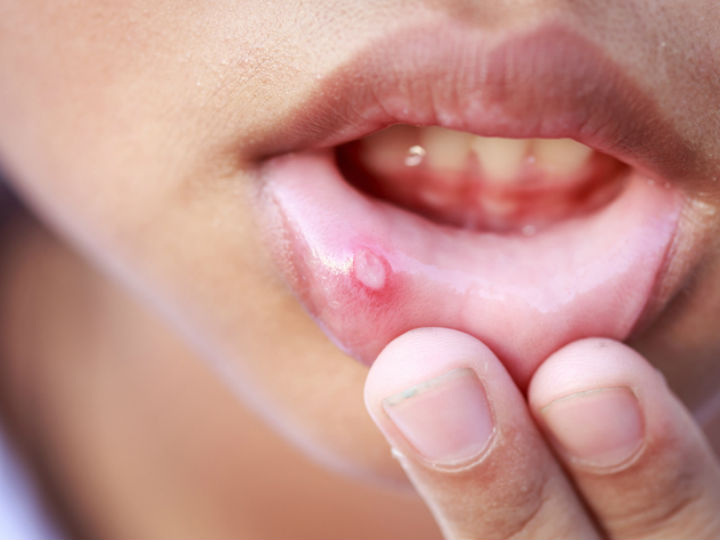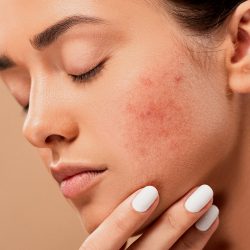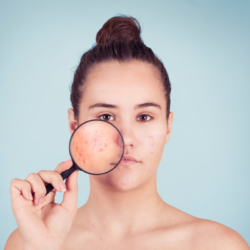What is a canker sore?
Canker sores, technically known as ” aphthous stomatitis “, are small ulcers that develop on the mucous membranes of the mouth. Contrary to popular belief, they are not contagious and should not be confused with lesions caused by herpes labialis, which is a viral infection.
These ulcers generally appear as small round or oval sores with a white or yellowish background and a red outline. Mouth ulcers vary in size, from a few millimetres for the most common to more than a centimetre for the most serious forms. They can also vary in duration, from a few days to several weeks, depending on their type and severity.
Characteristics of canker sores
The most notable feature of mouth ulcers is undoubtedly the pain they cause. This pain is often described as sharp or burning, especially when stimulated by movements such as talking, chewing, or even contact with food, particularly acidic or spicy foods.
Another important point is that mouth ulcers often appear suddenly. Some individuals may experience warning signs such as a tingling or burning sensation in the affected area a few hours or a day before the visible emergence of the ulcer.
What are the different types of mouth ulcer?
Mouth ulcers, although universally recognised for their unpleasantness, do not all present in the same way. In fact, they fall into several categories, each with its own distinct characteristics. Understanding these different types is essential for choosing the most appropriate treatment. Let’s explore the three main types of mouth ulcers: minor, major and herpetiform.
Minor mouth ulcers
Minor mouth ulcers are the most common. They are characterised by their small size, generally less than one centimetre in diameter. They look like small round or oval ulcers with a white or yellow centre and a reddish outline. The good news is that they are relatively benign. The pain they cause, although noticeable, is generally moderate and they heal on their own in one to two weeks without scarring. The majority of mouth ulcer sufferers are familiar with this form.
Major mouth ulcers
Major mouth ulcers are much less common, but more severe. They are larger, sometimes measuring more than a centimetre in diameter. These ulcers are often deeper and can take the form of irregular lesions. What makes them special is that they take several weeks or even months to heal, and the pain is often more intense. Major mouth ulcers can leave permanent scars in the mouth, adding to the importance of treating them appropriately.
Herpetiform canker sores
Despite their name, herpetiform canker sores have no connection with the herpes virus. This type of mouth ulcer appears in the form of multiple small lesions that can coalesce to form a large painful area. Because they appear in clusters, often dozens of them, they can be particularly uncomfortable. People with this type of canker sore may find it difficult to eat and speak because of the pain and discomfort they cause. Herpetiform canker sores usually heal within one to two weeks, but as with other types, treatment may be necessary to manage the pain and speed up the healing process.
How can you recognise a canker sore?
A canker sore should not be confused with canker sores associated with certain skin and mucous membrane diseases (erythema multiforme, penphigus, lichen planus), cancers (mucositis, oral carcinoma), certain chronic infections (oral syphilitic chancre, tuberculosis canker sore). herpes, herpangina, chickenpox, etc
A canker sore may also be associated with Behçet’s disease (a multi-organ disease responsible for canker sores, genitalia and eye lesions) or occur in inflammatory bowel disease (ulcerative colitis, Crohn’s disease).
What causes mouth ulcers?
- The aetiology is poorly understood, but immune factors seem to be involved: reactions to food, medicines and certain toothpastes (containing sodium lauryl sulphate).
- Mouth ulcers are more likely to be associated with underlying diseases (inflammatory bowel disease, coeliac disease, HIV infection, Behçet’s disease, immune problems)
- Hereditary component
What are the triggering factors?
- Histamine-rich foods: chocolate, nuts, hazelnuts, almonds, Swiss cheese, blue cheese, pineapple, citrus fruit, strawberries, grapes, apricots, shellfish….
- Stress, fatigue, local trauma to the oral mucosa
- Deficiency in iron, zinc, folic acid and vitamins (B12).
- Mostly affects women, with a link to hormones: flare-ups during pregnancy, menstruation, when taking the pill, etc.
- Stop smoking (tobacco thickens the oral mucosa, nicotine substitutes cause mouth ulcers)
How does it develop?
In common canker sores, small sores (less than 10 mm in diameter) heal spontaneously in one to two weeks, without scarring or complications. Ulcers may remain sporadic or recur after an interval of 1 to 4 months. Relapses generally disappear around adolescence, but sometimes last for years.
How can mouth ulcers be prevented?
-
Rigorous oral hygiene:
- Use a soft-bristled toothbrush.
- Brush regularly and floss daily.
- Include an antiseptic mouthwash in your oral care routine.
-
Dietary adjustments:
- Avoid irritating or allergenic foods (eggs, strawberries, exotic fruit, etc.).
- Ensure adequate vitamin D intake.
-
Prevention in early childhood:
- Give priority to breast-feeding or use hypoallergenic milk for infants.
- Carry out careful and gradual dietary diversification.
-
Strengthening the immune system:
- Live in an environment rich in beneficial microbes, such as a farm.
- Eat fermented foods regularly.
- Avoid excessive use of antibiotics during childhood.
What treatment should I choose for mouth ulcers?
Only common mouth ulcers in healthy people can be treated by self-medication.
In all other cases, a medical consultation is essential.
Local treatment
Local treatments should be limited to 5 days in order not to unbalance the oral flora.
Antiseptic treatment
- Antiseptic / antibacterial mouthwashes: Hextril®, Alodont®, Eludril®, Paroex®, SyntholOral. Use 2 to 3 mouthwashes a day after brushing your teeth. Be careful not to use mouthwashes for more than 5 days, as prolonged use alters the normal microbial flora of the oral cavity, encouraging the development of certain bacteria and fungal infections (thrush). Chlorhexidine solutions can discolour teeth, dentures and the tongue brown. This discolouration generally disappears after brushing the teeth and stopping treatment. Taste disorders have been reported with chlorhexidine and hexetidine in mouth rinses.
- Pain-relieving mouth wash: based on choline salicylate and salicylic acid (Pyralvex®…)
- Home-made analgesic mouthwash: dissolve 1g of aspirin in 1/2 glass of water and apply the solution directly to the mouth ulcer with your finger. Aspirin du Rhône, Aspirin Vit C UPSA, Aspro 500..
- Antiseptic solution: Pyralvex®, Pansoral®, Brorstyrol®, Aphtagel®, Flogencyl®..
- Antiseptic tablets : Lysopaine® Sucking tablets, Lyso-6 ®, Glossithiase ® , Strepsils®, Oropolis Vit C, these throat lozenges are to be sucked throughout the day (up to 6/day).
Local anaesthetic
- Lidocaine mouth cream ( Aftagel®, Dynexangival® 1%). Massage into the painful area. The effect is rapid (1 minute) and long-lasting (about 1 hour). Do not use more than 6 applications per day for adults and four for children over the age of 6.
- In certain cases of hyperalgesic mouth ulcers, topical corticosteroids may be prescribed by your doctor in combination with topical lidocaine. The main side effect of topical corticosteroids is the risk of oral candidiasis with long-term use.
Film-forming products
Film-forming products form a thin film that still adheres to the oral lesion. They form an insulating film and effectively protect the wound from external aggression and bacteria. This reduces pain and promotes healing.
They are made up of different media:
- Cellulose derivatives Urgo Aphtes Film-forming Solution..
- Synthetic polymers Isy Calm®, Gum Aftamed®..
- Xanthan gum: Doloaphte®, Aftamed® Gum
- Hyaluronic acid: Bloxaphte®, Hyalugel®, Borostyrol® oral gel, Aftosium® Spray..
Most of these preparations cannot be used in children (except Bloxaphte junior and Gum Aphtamed® Child oral gel for use from 36 months or Hyalugel® from 30 months).
Avoid eating and drinking for 30 minutes after use.
Preventive care
- The use of fixative creams (Polident®, Fixodent®) can help reduce the pressure of dentures on the gums.
- Protective orthodontic wax (Gum®) applied to appliances to cover the end of the wire or braces and cause discomfort or injury.
- Mouth ulcers can also occur if there is a lack of salivation. Use Evodry® Spay to regulate saliva flow
Chemotherapy-related mouth ulcers
To prevent mucositis (mouth ulcers that occur during chemotherapy), use Evomucy® mouthwash morning and evening after each meal for 1 to 2 minutes. Do not swallow.
For more information, please see our MUCITE® advice sheet
Analgesic treatment
Local treatment may be combined with an oral analgesic:
Paracetamol (Dolipraneoro®)
Ibuprofen Advil®, Advilcaps®, ADVILEFF®, Gelufen®, Spedifen® Nurofenflash®, Nurofen®, Nureflex®
Mouth ulcers and oligotherapy
Only common mouth ulcers in healthy people can be treated by self-medication. In other cases, medical consultation is necessary.
In the event of aphthosis
Oligotherapy: Oligosol Copper-Gold-Silver: 1 sublingual dose 2-3 / day
To avoid recurrence
Oligotherapy: Oligosol Manganese-Copper: 1 ampoule sublingually each morning
Mouth ulcers and phytotherapy
Only common mouth ulcers in healthy people can be treated by self-medication. In other cases, medical consultation is necessary.
Use one or more medicinal plants locally
- Calendula mother tincture: to be used diluted in water due to its alcohol content. Calendula has soothing, antiseptic and anti-inflammatory properties (due to the saponosides and carotenoids contained in the Calendula flower). Used to relieve irritation and itching. The mucilaginous substances (pectin and rubber) have moisturising and soothing properties.
For more information, see our Calendula leaflet
- Propolis: Oropolis®: suck on for greater effectiveness.
To find out more, read our advice card: Propolis
- Liquorice can be used as a gargle and mouthwash for mouth ulcers and stomatitis.
To find out more, read our liquorice advice card
- Sage is an excellent medicine. Apply a local infusion of sage or gelDologel®.
Mouth ulcers and homeopathy
Only common mouth ulcers in healthy people can be treated by self-medication. In other cases, a medical consultation is essential
Symptomatic treatment
- Borax 9CH 5 granules every 2 hours as a treatment
- Aftosium® and Homéoaftyl® lozenges: 1 tablet to be sucked slowly 4 to 5 times a day between meals.
Homeopathic treatment
Recurrent aphthoses, alternating with sore throats or recurrent gingivitis, are characteristic signs of luesis.
Mercurius corrosivus 15CH and Borax 15CH 1 dose each every 15 days.
Other subjects will also have a tendency to develop certain types of mouth ulcers
- Aphthosis with purulent exudate in an “exhausted alcoholic”: Sufluricum acidum
- Mouth ulcers at the tip of the tongue: Lycopodium
Mouth ulcers and aromatherapy
Essential oils
- Clove essential oil has anaesthetic and anti-infectious properties. Mix a cup of alcoholic mouthwash with 1 drop of clove essential oil and use it as a mouthwash up to 3 times a day
- Tea tree essential oil is useful for treating mouth ulcers because of its antiseptic properties. It can be applied directly to mouth ulcers using a cotton bud.
Ready to use
Our APHTE Preparation with essential oils is a natural, effective remedy for soothing the pain associated with mouth ulcers and minor mouth sores. This liquid formula, with the healing properties of essential oils, offers accelerated healing and instant relief.
Apply directly to mouth ulcers.
How can I prevent mouth ulcers with nutritional supplements?
Vitamin C
Vitamin C treatments are beneficial in preventing the recurrence of mouth ulcers. Choose the natural vitamin C found in acerola berries.
Vitamin C and acerola: 3 Chêne Acérola 500, 3 Chêne Bio Acérola 1000, Acérola 1000 Arkopharma®, Acérol C vitamin C, Acérola Arkogélules®, Acérola Bio 500, Acérola Plus 500, DAYANG® Acérola 1000, Vitascorbol® 500, Vitascorbol® 1g.
Combinations of vitamins, zinc and plants
Certain nutritional supplements combining vitamins (vitamin B1 = thiamine, vitamin B3 = niacin, vitamin B6), zinc and medicinal plants such as aloe vera treat and prevent relapses in certain cases of recurrent aphthosis.
For optimum results, a treatment of at least 4 weeks once a day is required.
Health advice from your pharmacy
Any pain in the teeth or gums requires a dental check-up. If the pain is severe, the gums are bleeding and/or there is a fever, consult a dentist as a matter of urgency.







